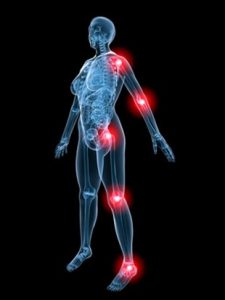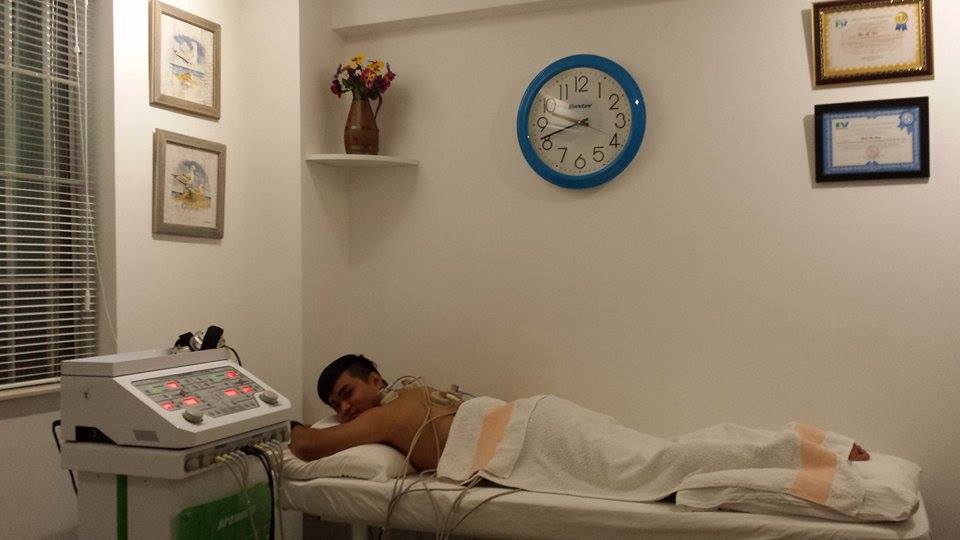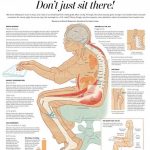Electrotherapy is a type of transcutaneous (goes through the skin) nerve and muscle stimulation by electrical current. Improvement is often noted after the first session – as evidenced by reduced pain, diminished swelling, and improved mobility. Electrotherapy treatment is often given as an adjunctive modality for a variety of conditions.
The key to electrical stimulation is its waveform, which allows the electrical current to penetrate deep within the tissues being treated. Because it goes through the skin, needles are not used in this therapy. Another key is its combination of electrical frequencies.
It works so safely and comfortably that usually patients feel only mild “pins and needles” tingling, and a gentle sensation of pressure.
Benefits
One benefit includes helping to relieve pain syndromes following strain or sprain injuries. Electrotherapy also helps relax spasms and reduce swelling and pain in many back and neck problems. In addition, Electrotherapy may help reduce swelling and pain for such conditions as tennis elbow, carpal tunnel syndrome, shoulder and knee injuries and frequently helps persistent, post-surgical pain.
Electrotherapy treatment may help prevent or retard tissue atrophy when a limb is in a cast or immobilized. It may help increase local blood circulation. It can also help build strength in muscles, tendons, and ligaments – especially following injury. Electrotherapy often helps reduce swelling and accelerate the healing process. It is useful in restoring normal freedom and range of motion in those who experience stiffness or limitation of movement.

Increased Range of Motion – Electrotherapy is often used to help relieve pain and aid in the treatment of muscle injuries such as strains, sprains, spasms, tears and bruises. It can also help to increase range of motion and slow or prevent muscle atrophy (muscle which is wasting away because of non-use).
Sports Injuries – Electrotherapy is often used to treat injured athletes – helping them to recover more rapidly. It is not only useful in treating injuries, but it also aids in the recovery of muscles from extensive training or over-exertion.
Chronic Problems – Electrotherapy treatments may be beneficial for many conditions – whether they are in the acute or chronic stage. When health problems persist longer then the “normal” recovery time – they are deemed to be chronic. Electrotherapy can benefit those who suffer with longstanding, residual, and chronic conditions.
Electrotherapy treatments using low-frequency and highfrequency forms of current!
In electrotherapy, the entire body or certain specific body parts are subjected to DC or AC currents.
The use of electric currents in the treatment of different pain syndromes has a long tradition, which dates back to the time of the Emperor Claudius, 46 AD. With the help of targeted dosage and a large choice of different forms of current, it is possible to deploy electrotherapy both in the treatment of pain as well as for improving blood circulation and stimulation of the muscles. Electrotherapy is divided into three large fields, the lowfrequency, the medium-frequency and the high-frequency currents.
High-frequency therapy
The high-frequency electrotherapy is subdivided in the application forms of Arsonvalisation, diathermy and short-wave therapy. As far back as in 1881, Nikola Tesla generated high-frequency AC currents for the first time with high voltage, whose favourable effects were recommended shortly thereafter by the French physiologist, J. D’Arsonval, for therapy. The Arsonvalisation is related to electric AC currents, with frequencies ranging from 100 to 1,000,000 Hz, which do not produce any heat. The founder, MR Dr. Otto Nuhr, has undertaken advanced development on the Arsonval currents, and they are used in very few specialist centers owing to the high level of technical effort and know-how required for this purpose.
Technical details
The high frequencies are generated in electric resonant circuits, which consist of an electrical energy storage, the capacitance, an electromagnetic energy storage, the inductance and a switching device and the spark gap. The voltage in the primary electrical damped resonant circuit is stepped up from 40,000 volts by a Tesla transformer to the operating voltage of 100,000 to 300,000 volts.
Effect of the Arsonvalisation
The specific effects of the Arsonval currents are not merely limited to the alleviation of pain, but also concern various functional complexes of the organism. Studies have shown that the Arsonval currents, modified according to Dr. Otto Nuhr, not only promote the metabolism, but also promote the activation and precipitation of the stress hormone production, which, in turn, has a favourable impact on the recuperation and reduction of the intensity of the pain. At the Nuhr Medical Center, the high-frequency therapy is used for the treatment of diseases pertaining to the spinal column and vertebral discs as well as for rheumatic diseases and also for arterial circulatory disorders or with overworking, stress conditions and reduction of the physical performance capability of the body.
Medium-frequency AC currents/Interference currents
Depending on the form of application, the primary effect is the alleviation of pain or the stimulating impact with muscle contraction and subsequent muscle relaxation. In the process, circulation improves, swellings are reduced and the musculature is relaxed.
The low-frequency therapy …
… is treatment using currents having low intensity and a frequency below 1,000 Hz. The treatment promotes local blood circulation and muscle build-up, and inhibits inflammation and reduces swellings. Above all, in the event of weakened and partially paralysed musculature, the function of the muscle can be maintained and the weakness can be reduced.
When is electrotherapy used?
The area of application is very large on account of the diverse effects of electrical currents. Electrotherapy is used for
- Promoting blood circulation
- Stimulating the muscle activity
- Influencing the nerves and the transmission of pain (alleviation of pain)
- Warming the skin and tissues lying deeper
- Stimulation of the metabolism processes and reinforcing the body’s defence mechanism.
Treatment using electrical currents is helpful and supportive in case of the following diseases or disorders:
- Pain syndrome at the locomotor system
- Muscle tensions and muscle pulls
- Muscle weakness and muscle paralysis after accidents
- Muscle weakness after operative incisions (e.g. knee joint arthroscopy)
- Muscle weakness after longer periods of inactivity (e.g. when bed-ridden)
- Muscle weakness and muscle paralysis caused by neurological disorders (accompanying therapy)
- Incontinence with weakness or paralysis of the pelvic floor or bladder musculature
Other treatments in the field of electrotherapy:
- Threshold current is a medium-frequency current, which brings the skeletal muscles to a specific and dosed level of tension and, thus, not only prevents muscular atrophy, but also promotes muscle build-up. Since recent times, low-frequency therapy equipment has been in use that is compatible with metallic materials. Thus, you can also treat implants such as artificial joints, with certain forms of current without any risk.
- Exponential current: a low-frequency targeted stimulation of muscle fibres, which are no longer supplied by nerves. Both types of current can be meaningful in the case of neuro-muscular diseases, in order to stimulate musculature, improve blood circulation and to give the patient a renewed feeling of mobility.
- Galvanic currents: In the case of treatments using weak DC, one differentiates between simple galvanisation (without the use of medication) and iontophoresis. In galvanisation without medicaments, a damping and painalleviating effect arises in the region of the anode, the cell is more difficult to stimulate and the transmission of stimulus diminishes. In the cathode region, a stimulating effect occurs, since the cell can be stimulated more easily and the transmission of stimulus increases. The change of the ionic milieu in the body causes enhanced blood circulation in the entire region undergoing treatment.
- Iontophoresis: Iontophoresis, a special form of DC treatment, is used to transfer medicaments into the body on the basis of the ionic movement. The effect of the galvanic current is thus pharmacologically reinforced.
- Stangerbad (Hydroelectric bath): a hydroelectric bath in a special bathtub made of plastic with graphite electrodes, which conduct a weak DC current through the body. Medicaments can be added to the water. Heating, buoyancy of the body in the water and, last, but not the least, the resorption of the medicaments via the skin improve the blood circulation and muscles lying deep within, and enhance the metabolism. It is used for muscle tensions, backaches, complaints of the shoulder, arms and legs, sciatica, arthrosis and other rheumatic diseases.
- Cell bath: a special form of application of galvanisation, in which the electrical current flows through the water, in which the hands/legs are placed. It is recommended for joint pains in the hands and feet, in case of radiating pains in the arms or legs and in case of problems with the sensation in the feet.
- Exciting current or impulse current: Low-frequency impulses of specific intensity, pulse duration, rise time and frequency can stimulate either indirectly via the motor nerve fibres or directly. Similarly, nerves and other excitable structures are stimulated.
- TENS: a multi-purpose form of therapy in the treatment of chronic pain syndromes. In conventional methods, only low intensities and higher frequencies (around 100 Hz) are used, while the acupuncture form uses high intensities and low frequencies (2– 8 Hz). In most cases, the electrodes are placed over the painful region.


Dr Hoa pain clinic IS USING:
1. High-frequency currents therapy
2. Interference currents therapy
3. Low-frequency therapy





